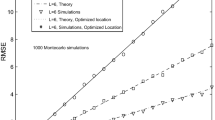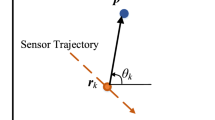Abstract
Three-dimensional (3D) target localization by using hybrid time difference of arrival (TDOA) and angle of arrival (AOA) measurements from multiple sensors has been an active research area for several decades due to its extensive applications in various fields. For this nonlinear estimation problem, the pseudolinear system of equations constructed by using the measurements generally acts as the basis of numerous localization algorithms. In this paper, we aim to improve the performance of 3D TDOA–AOA localization by introducing the constrained total least squares (CTLS) framework wherein the inherent characteristics of the pseudolinear equations can be properly taken into consideration. On the basis of the total least squares model, the CTLS model for 3D TDOA–AOA localization is established by imposing the inherent characteristics of the pseudolinear equations as additional constraints. Then, the multi-constraint optimization problem in CTLS model is solved by using an iterative algorithm based on successive projections. Extensive numerical simulations are accomplished for evaluating the performance of the proposed CTLS algorithm. The results show that the proposed algorithm gives moderate accuracy enhancement with acceptable computational cost, and more importantly, it is more robust to large measurement noise than the compared algorithms.






Similar content being viewed by others
Data Availability
The datasets generated during and/or analyzed during the current study are available from the corresponding author on reasonable request.
References
T.J. Abatzoglou, J.M. Mendel, G.A. Harada, The constrained total least squares technique and its applications to harmonic superresolution. IEEE Trans. Signal Process. 39(5), 1070–1087 (1991)
R. Arablouei, K. Dogancay, Linearly-constrained recursive total least-squares algorithm. IEEE Signal Process. Lett. 19(12), 821–824 (2012)
A.N. Bishop, B. Fidan, K. Doğançay, B.D.O. Anderson, P.N. Pathiranaa, Exploiting geometry for improved hybrid AOA/TDOA-based localization. Signal Process. 88(7), 1775–1791 (2008)
J. Bosse, O. Krasnov, A. Yarovoy, Direct target localization with an active radar network. Signal Process. 125, 21–35 (2016)
J. Cao, Q. Wan, X. Ouyang, H.I. Ahmed, Multidimensional scaling-based passive emitter localisation from time difference of arrival measurements with sensor position uncertainties. IET Signal Process. 11(1), 43–50 (2017)
W. Chen, M. Chen, J. Zhou, Adaptively regularized constrained total least-squares image restoration. IEEE Trans. Image Process. 9(4), 588–596 (2000)
K. Doğançay, Bearings-only target localization using total least sqaures. Signal Process. 85(9), 1695–1710 (2005)
K. Doğançay, Passive emitter localization using weighted instrumental variables. Signal Process. 84(3), 487–497 (2004)
K. Doğançay, G. Ibal, Instrumental variable estimator for 3D bearings-only emitter localization, in 2005 International Conference on Intelligent Sensors, Sensor Networks and Information Processing (2005), pp. 63–68
J.A. Gadzow, Total least-squares matrix enhancement and signal processing. Digit. Signal Process. 4, 21–39 (1994)
G.H. Golub, C.F. Van Loan, An analysis of the total least squares problem. SIAM J. Numer. Anal. 17(6), 883–893 (2006)
K.C. Ho, Bias reduction for an explicit solution of source localization using TDOA. IEEE Trans. Signal Process. 60(5), 2101–2114 (2012)
T. Jia, H. Wang, X. Shen, J. Gao, X. Liu, An accurate TDOA–AOA localization method using structured total least squares, in IEEE OCEANS 2017 (2017), pp. 1–6
T. Jia, H. Wang, X. Shen, Z. Jiang, K. He, Target localization based on structured total least squares with hybrid TDOA–AOA measurements. Signal Process. 143, 211–221 (2018)
F. Jiang, Z. Zhang, An improved underwater TDOA/AOA joint localisation algorithm. IET Commun. 15, 802–814 (2020)
L. Kraljević, M. Russo, M. Stella, M. Sikora, Free-field TDOA–AOA sound source localization using three soundfield microphones. IEEE Access 8, 87749–87761 (2020)
J.C. Lagarias, J.A. Reeds, M.H. Wright, P.E. Wright, Convergence properties of the Nelder–Mead simplex method in low dimensions. SIAM J. Optimiz. 9(1), 112–147 (1998)
T. Le, K.C. Ho, Joint source and sensor localization by angles of arrival. IEEE Trans. Signal Process. 68, 6521–6534 (2020)
Q. Li, B. Chen, M. Yang, Improved two-step constrained total least-squares TDOA localization algorithm based on the alternating direction method of multipliers. IEEE Sens. J. 20(22), 13666–13673 (2020)
J. Luo, X. Shao, D. Peng, X. Zhang, A novel subspace approach for bearing-only target localization. IEEE Sens. J. 19(18), 8174–8182 (2019)
F. Ma, Z. Liu, F. Guo, D. Feng, L. Yang, Joint TDOA and FDOA estimation for interleaved pulse trains from multiple pulse radiation sources. IEEE Trans. Aerosp. Electron. Syst. 56(5), 4099–4111 (2018)
I. Markovsky, S.V. Huffel, Overview of total least-squares methods. Signal Process. 87(10), 2283–2302 (2007)
S. Poursheikhali, H. Zamiri-Jafarian, Source localization in inhomogeneous underwater medium using sensor arrays: received signal strength approach. Signal Process. 183, 108047 (2021)
F. Qu, F. Guo, W. Jiang, X. Meng, Constrained location algorithms based on total least squares method using TDOA and FDOA measurements, in International Conference on Automatic Control and Artificial Intelligence (ACAI 2012) (2012).
H.C. So, F.K.W. Chan, A generalized subspace approach for mobile positioning with time-of-arrival measurements. IEEE Trans. Signal Process. 55(10), 5103–5107 (2007)
M. Sun, L. Yang, D.K.C. Ho, Efficient joint source and sensor localization in closed-form. IEEE Signal Process. Lett. 19(7), 399–405 (2012)
S. Tomic, M. Beko, R. Dinis, RSS-based localization in wireless sensor networks using convex relaxation: noncooperative and cooperative schemes. IEEE Trans. Veh. Technol. 64(5), 2037–2055 (2015)
Y. Wang, K.C. Ho, An asymptotically efficient estimator in closed-form for 3-D AOA localization using a sensor network. IEEE Trans. Wirel. Commun. 14(12), 6524–6535 (2015)
H. Wei, R. Peng, Q. Wan, Z. Chen, S. Ye, Multidimensional scaling analysis for passive moving target localzaiton with TDOA and FDOA measurements. IEEE Trans. Signal Process. 58(3), 1677–1688 (2010)
K. Yang, J. An, X. Bu, G. Sun, Constrained total least-squares location algorithm using time-difference-of-arrival measurements. IEEE Trans. Veh. Technol. 59(3), 1558–1562 (2010)
J. Yin, Q. Wan, S. Yang, K.C. Ho, A simple and accurate TDOA–AOA localization method using two stations. IEEE Signal Process. Lett. 23(1), 144–148 (2016)
X. Zhang, W. Zhu, Wavelet domain image restoration using adaptively regularized constrained total least squares, in Proceedings of 2004 International Symposium on Intelligent Multimedia, Video and Speech Processing (2004), pp. 567–570
Y. Zhao, Z. Li, B. Hao, J. Si, P. Wan, Bias reduced method for TDOA and AOA localization in the presence of sensor errors, in 2017 IEEE International Conference on Communications (ICC) (2017), pp. 1–6
Acknowledgements
This work was supported by the National Natural Science Foundation of China (Grant No. 61901383) and the Fundamental Research Funds for the Central Universities (Grant No. 3102021HHZY030011).
Author information
Authors and Affiliations
Contributions
ZX contributed to methodology, software, investigation, and writing—original draft. HL contributed to conceptualization, formal analysis, supervision, writing—review and editing, and funding acquisition. KY contributed to resources, data curation, and project administration. PL contributed to validation and visualization.
Corresponding author
Ethics declarations
Conflict of interest
The authors have no conflicts of interest to declare.
Additional information
Publisher's Note
Springer Nature remains neutral with regard to jurisdictional claims in published maps and institutional affiliations.
Appendices
Appendix A: The derivation of the BR-WLS algorithm
Based on Eq. (20), the cost function of the WLS model can be equivalently written as
where
In Eq. (38), the matrices \({\hat{\mathbf{A}}}, \, \hat{\boldsymbol{h}}\) and \({\mathbf{W}}\) are expanded by zero. Let \({\hat{\mathbf{G}}}_{o} = [{\hat{\mathbf{A}}}_{o} , - \hat{\boldsymbol{h}}_{o} ]\) and \({\varvec{\eta}} = [{\varvec{u}}^{T} ,1]^{T}\) be the intermediate matrix and vector, then Eq. (37) can be expressed as
In practice, the matrix \({\hat{\mathbf{G}}}_{o}\) is noise corrupted and can be decomposed as
where Go denotes the true counterpart of \({\hat{\mathbf{G}}}_{o}\). After some direct algebraic manipulations, the noise contamination term ΔGo can be approximated as
where we omit some θ1(or φ1)-related terms for a simpler expression (Note that although we make some truncation here, it is shown by simulations that this algorithm still can improve the localization performance over the WLS algorithm). The matrix Γ contains the measurement noise and Λi, i = 1, 2, 3 are the corresponding coefficients related to each noise term. They are, respectively, defined as
The matrices Fi,θ, Fj,φ, and F3,τ are defined with their nth row, n = 1, 2, …, K, given by
Substituting Eq. (40) into Eq. (39) results in
whose mathematical expectation can be given as
Clearly, the second term in Eq. (45) makes the minimum of E[J] deviate from the ideal solution (i.e., zero) and causes the estimation bias since it changes with η. The idea of the bias reduction technique is to minimize J subject to \({\varvec{\eta}}^{T} E[\Delta {\mathbf{G}}_{o}^{T} {\mathbf{W}}_{o} \Delta {\mathbf{G}}_{o} ]{\varvec{\eta}}\) equaling to a constant [28]. Therefore, the bias reduction model can be constructed as
where \({{\varvec{\Omega}}} = E[\Delta {\mathbf{G}}_{o}^{T} {\mathbf{W}}_{o} \Delta {\mathbf{G}}_{o} ]\). The constant k does not affect the final solution and it can be any positive value. The Lagrange multiplier technique can be applied to solve the problem and the corresponding auxiliary function can be constructed as
where λ is Lagrange multiplier. Taking the derivate of Eq. (47) with respect to η and setting it to zero lead to
Premultiplying ηT at both sides of Eq. (48) and considering the constraint in Eq. (46), we arrive at \({\varvec{\eta}}^{T} {\hat{\mathbf{G}}}_{o}^{T} {\mathbf{W}}_{o} {\hat{\mathbf{G}}}_{o} {\varvec{\eta}} = \lambda k\), indicating that the solution of η is the generalized eigenvector corresponding to the minimal generalized eigenvalue of the matrix pair \(({\hat{\mathbf{G}}}_{o}^{T} {\mathbf{W}}_{o} {\hat{\mathbf{G}}}_{o} , \, {{\varvec{\Omega}}})\). The bias-reduced solution can then be given as
The matrix Ω can be calculated as
where the matrices Woi,j i, j = 1, 2, 3 are defined in Eq. (38). Supported by Eq. (50), it is straightforward to obtain
where ⊙ denotes the Hadamard production. In practice, the values of AOA and TDOA measurements in Λi, i = 1, 2, 3 can be replaced by their noisy counterparts and this algorithm is named as BR-WLS in this paper.
This bias-reduced technique was first proposed for TDOA localization problem in Ref. [12] and then utilized for AOA localization in Ref. [28]. Here, we derive the BR-WLS algorithm for the 3D TDOA–AOA localization problem. Although a similar work seems to have been reported in Ref. [33], we shall declare that the algorithm in Ref. [33] is designed for two sensors while the one derived here is more universal and suitable for multiple sensors.
Appendix B: The CRLB of 3D TDOA–AOA localization problem
Assume that the measurement noise vector \(\varvec{e}\in\mathbb{R}^{3K-1}\) is zero-mean Gaussian with the covariance matrix \(\varvec{Q}\in\mathbb{R}^{(3K-1)\times(3K-1)}\). The fisher information matrix (FIM) conforms the following expression:
Based on Eqs. (2)–(4), the partial derivatives in Eq. (52) can be expressed as
where
where \(d_{k} = \sqrt {(u_{x} - s_{k,x} )^{2} + (u_{y} - s_{k,y} )^{2} }\) denotes the horizontal distance between the target and the kth sensor. The CRLB can be computed from the inverse of FIM and it holds the expression CRLB = FIM−1. It describes the lower bound of RMSE that an unbiased estimator can achieve. Although most of the existing algorithms are typically biased, the CRLB is still an important benchmark in terms of RMSE performance, particularly when the estimation bias is significantly smaller than variance.
Appendix C: Computational Complexity Analysis of the Investigated Algorithms
See Tables 3, 4, 5, 6, 7 and 8.
Rights and permissions
Springer Nature or its licensor (e.g. a society or other partner) holds exclusive rights to this article under a publishing agreement with the author(s) or other rightsholder(s); author self-archiving of the accepted manuscript version of this article is solely governed by the terms of such publishing agreement and applicable law.
About this article
Cite this article
Xu, Z., Li, H., Yang, K. et al. A Robust Constrained Total Least Squares Algorithm for Three-Dimensional Target Localization with Hybrid TDOA–AOA Measurements. Circuits Syst Signal Process 42, 3412–3436 (2023). https://doi.org/10.1007/s00034-022-02270-6
Received:
Revised:
Accepted:
Published:
Issue Date:
DOI: https://doi.org/10.1007/s00034-022-02270-6




